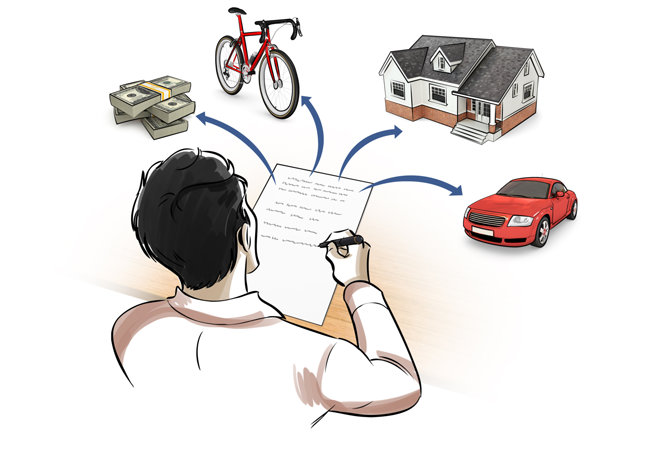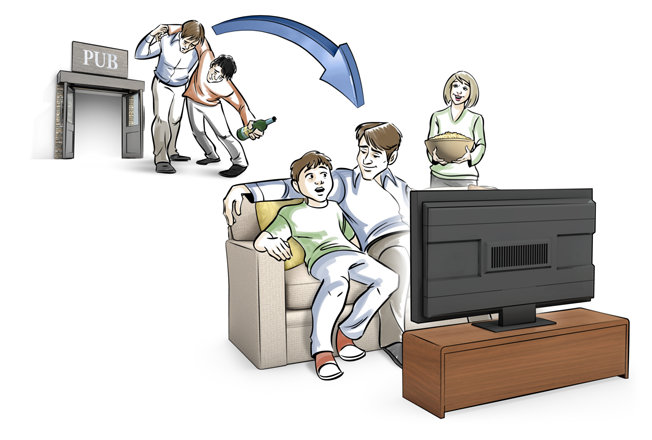Ways to Lessen the Threat
People are looking for a less threatening environment, or at least for a way to better survive the environment they live in.
A person has everything identified (made to seem the same) with that part of the environment which is threatening. If you get him to differentiate (be able to tell the difference) and find out there are some parts of the environment that aren’t threatening, he will make a lot of progress.
Just the idea that he considers the environment dangerous and overwhelming and that he doesn’t quite know where that danger or overwhelm is coming from—that idea alone is an enormous piece of wisdom. It has never occurred to him before. He has just felt it, all the time.
You can help him by having him inspect some areas of his environment and notice that it was being made more dangerous than it actually is. To inspect is to look at or examine something carefully.
Your effort is simply to get him to inspect his environment and find out that it contains less threat than he had been led to believe.
All a person has to do is study his environment a little bit.
The results can be remarkable. His physical and mental alertness can be improved. You can better his ambition and the amount of activity he is involved in. His health may actually improve a bit.
What does he expect? It may only be this: that he just won’t be so frightened when the doorbell rings. We are talking now about a very tiny improvement. But nevertheless, this improvement would be enormously real to him.
When he wakes up in the morning he doesn’t have an agonizing feeling that something horrible is going to happen. This might not disappear, but perhaps get less. He will be a little more active in life.
He is likely to get more benefit than you expect and also more than he expects.
Here are the procedures you can use to do this:
1. Don’t Read the Newspaper for Two Weeks
Tell the person, “Don’t read the newspapers for two weeks and you will feel better.”
If he doesn’t read the newspapers for two weeks, of course he will feel better.
Then tell him, “Now read the newspaper for a week, and at the end of that week you will find you feel worse. Then make up your mind whether or not you ought to pay any attention to the newspapers.”

This could be done as a simple experiment. It isn’t even an expensive
2. Look Around the Environment and Find Something That Isn’t Being a Threat
Tell him:
“Look around the environment and find something that isn’t being a threat to you.”

Or let’s say a person is very worried that things are going to fall on him. Tell him:
“Look around here and find something that isn’t going to fall on you.”
After some time, perhaps, he would find one thing someplace. You must make him find the one thing that isn’t going to fall on him and he feels much better. He might even realize that he thought everything was going to fall on him. He’s already told you this, but he now knows it by inspecting the environment.
You ask the question until the person is happy or relieved and has had a realization about himself, the environment or life in general.
Every person has a different environment to every other person, so you might have to adjust the wording. Here’s an example of a wrong wording, however: let’s say someone is very worried about something happening in China. To say, “Well, what threat have the Chinese ever been to you, anyhow, that you’re so worried about?” does not work. Now he has to protest and explain his own thinking. He has to get himself caught up trying to prove he’s right and you’re wrong. So use the wording given above, changing it only as necessary.
You can use this technique on yourself. You might be very worried about a problem you have. You can ask yourself:
“Is there anything around that isn’t pushing this problem at me?”
It might take you a few minutes to get the question answered.
Or you may be sitting at your desk with papers piling up. Everything seems to be in an uproar. Your desk is covered with papers demanding your attention. You should be able to look at the papers on your desk. They’re the source of the threat. Find something about them that isn’t a threat. The threat will balance out in the discovery.
3. Take a Walk
Another way of having a person look at the environment and discover that it isn’t so threatening is a technique called “Take a Walk.” If a person feels bad, have him take a walk and look at things as he walks. He should really look at them.

The reason this works is that the person finds out that the environment is not threatening.
“Take a walk and look at things” is the mildest advice that you could possibly give anybody, and is almost certain to produce a result if the person will do it. It is quite effective.
4. Find Something That Isn’t Hostile to You
A person feels that people are hostile (unfriendly or showing dislike) to him. Ask him:
“Find something people say or do around here that isn’t hostile to you.”
or
“Is there one person in the organization who isn’t actively hostile to you?”
or
“Is there anything said today that wasn’t directly and immediately hostile to you?”

Continue this until the person feels better, is happier and has had a realization about himself, the environment or life in general.
5. Handling a Loss
Someone who has just lost his girlfriend, or a woman who has lost her man, feels the horrible sadness and loss it gives everything. Everything in the environment will talk to him or her about the lost love. For a period of time, it will be impossible for him to look around and not be reminded of this person.
When a person’s attention has been very much on another person, it is sometimes very, very difficult not to connect everything with that person. The thing to do is find something that isn’t reminding the person of the one he or she lost. He might have to search a long way to find something.
This is a way to recover from a love affair. The person has identified everything in the environment with his upset. By directing the person’s attention to things in the environment which are not so connected and making him find things which are not actively reminding him, you get a differentiation (the ability to notice the difference between two or more things). Before that, there had been an identification (regarding a thing as exactly the same as another). Where a differentiation exists, intelligence and judgment can return.
Tell him or her, “Find something that isn’t reminding you of ________ (name of person he or she lost).”

Keep getting the person to find something else that is not reminding him or her of the person until he or she has a realization and feels better.
6. Arranging One’s Life
By having someone plan a life by which he could live calmly and unthreatened, the life he is living becomes less threatening.
Let’s say the person has to keep his job even though it doesn’t pay enough. There’s no chance of him getting something else. He finds that environment very hostile. This man is in a box of his own making.
Get him to plan a life which would not be so threatening, no matter how wildly he plans it or how he dreams it up. He will be able to go on working at his job much more happily and feeling much calmer.

The basic problem a person has had is how to get into a less threatening environment or, if he can’t do that, how to deal better with the one he has.
7. Knocking Off Things That Cause Upset
This is to have the person stop doing things that upset him or stop talking to people who upset him.
You could say to the person, “Knock off some of the things in your life that make you upset.”

Or ask, “Who upsets you? Well, don’t talk to them for a while.”
Or ask him, “What activities leave you feeling worse? Well, just don’t do them for a while.”
Or possibly ask him, “What things in the environment aren’t really a threat to you? All right, have you got some of those? Fine. Associate with those. Pay more attention to them.”

